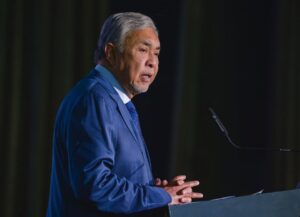
THE world is celebrating US president Donald Trump‘s Gaza Peace Plan as if it is the dawn of a new era.
Hamas and Israel have signed on, hostages are set to be exchanged, and international mediators are congratulating themselves.
But let’s be clear that this is not made in a desire for peace; it is political theatre, staged to elevate Trump‘s image as a peacemaker and timed perfectly to boost his chances at the Nobel Peace Prize.
(On Friday, the prize went to Venezuela’s Opposition leader María Corina Machado.)
On the surface, Israel displays the pretence of “respecting” Trump for his graciousness in his role as chief “peace negotiator”. Trump is far from being a promoter of peace in the Middle East, especially in the context of Palestine-Israel.
How could he be: In front of the cameras Trump talks about ending the war in Gaza, but behind the scenes he continues to send weapons of mass destruction to Israel to “finish the job”.
Trump’s desperation to win the Nobel Peace Prize is no secret. He has paraded his supposed accomplishments in Gaza, Iran, and even India-Pakistan as proof of his statesmanship.
The Gaza Peace Plan was to be his ticket to Oslo. But for
Palestinians, it is a ticket to nowhere. The plan contains no guarantee of full Israeli withdrawal. Even with international forces on the ground, Israeli troops will remain. That is not liberation – it is occupation under a new label.
We have seen this play before. In January, Trump’s first ceasefire was trumpeted as a breakthrough. By March, Israeli Prime Minister Benjamin Netanyahu had shredded it, resuming the bombardment of Gaza.
Why should anyone believe that Trump’s Gaza Peace Plan will be different? Israel has a long history of defying agreements with Palestinians, and Netanyahu has perfected the art of exploiting loopholes.
The truth is that this deal is transactional. It is about the captives, not justice. Israel will get its captives back, Palestinians will see some detainees released, and then – once the exchange is complete – the ceasefire will most likely collapse.
The genocide will resume, and the world will once again wring its hands while Gazans bury their dead.
Trump will not care. The Nobel Prize has been awarded and he has not secured the image he craves: the dealmaker who brought peace to Gaza.
If Israel resumes its onslaught, he will dismiss it with a shrug or a bizarre statement, revealing once again that his leadership is transactional, not principled.
The plan also suffers from a glaring absence of accountability mechanisms. There are no provisions for independent monitoring of Israeli compliance, nor any penalties if the ceasefire is violated.
Without enforcement, agreements are little more than paper promises. Palestinians have lived through decades of such hollow accords, where violations are met with silence or, worse, tacit approval from the very powers meant to guarantee peace. This time is no different.
Moreover, the plan sidelines Palestinian agency. This is an obvious pattern – when Trump first threw out his idea of the “Riviera”, it was totally his idea alone, with absolutely no concern for the Palestinians.
While Hamas has been pressured into acceptance, the broader Palestinian political spectrum – including civil society, diaspora voices, and even the Palestinian Authority – has been marginalised. A ceasefire imposed from above, without genuine consultation, risks entrenching divisions rather than healing them. It reduces Palestinians to spectators in their own struggle, forced to accept terms crafted to serve external interests.
The regional implications are equally troubling. By presenting this deal as a triumph, Trump and Netanyahu are attempting to normalise a status quo where occupation is rebranded as “peace”.
This sets a dangerous precedent for other conflicts: that temporary truces, devoid of justice, can be sold as solutions.
It emboldens authoritarian leaders across the region who view Trump’s transactional diplomacy to be a model for suppressing dissent while winning international applause.
Economically, the plan offers little beyond promises of aid and reconstruction – promises that have been made and broken countless times before. Gaza’s infrastructure lies in ruins, its economy strangled by blockade, and its people traumatised by years of bombardment.
Without lifting the siege, without restoring freedom of movement and trade, no amount of aid will create sustainable recovery. The plan’s economic provisions are a bandage on a gaping, festering wound.
The timing of this deal cannot be ignored. While Trump’s Nobel ambitions were looming, the Gaza Plan was less about ending suffering and more about securing a legacy.
It is peace built on sand: unstable, temporary, and destined to collapse under the weight of its contradictions.
When it does, the world will once again express shock, but the Palestinians will be the ones to pay the price – with their lives, their homes, and their future.
The euphoria surrounding this plan is dangerous. It blinds the world to the fact that Pales-tinians are being offered temporary relief, not lasting peace.
It allows Israel to reset the clock, regroup, and prepare for the next round of invasion. And it rewards Trump for a performance that prioritises his personal glory over Palestinian survival.
Without guarantees, accountability and a genuine commitment to Palestinian rights, Trump’s Gaza Peace Plan is doomed to collapse.
The tragedy is that when it does, it will not be Trump or Netanyahu who pay the price. It will be the people of Gaza, once again betrayed by the false promises of powerful men.
Dr Abdul Latiff Mohd Ibrahim is head of the Research and Publications Division at the International Institute of Advanced Islamic Studies (IIAIS) Malaysia. The views expressed here are solely the writer’s own.






